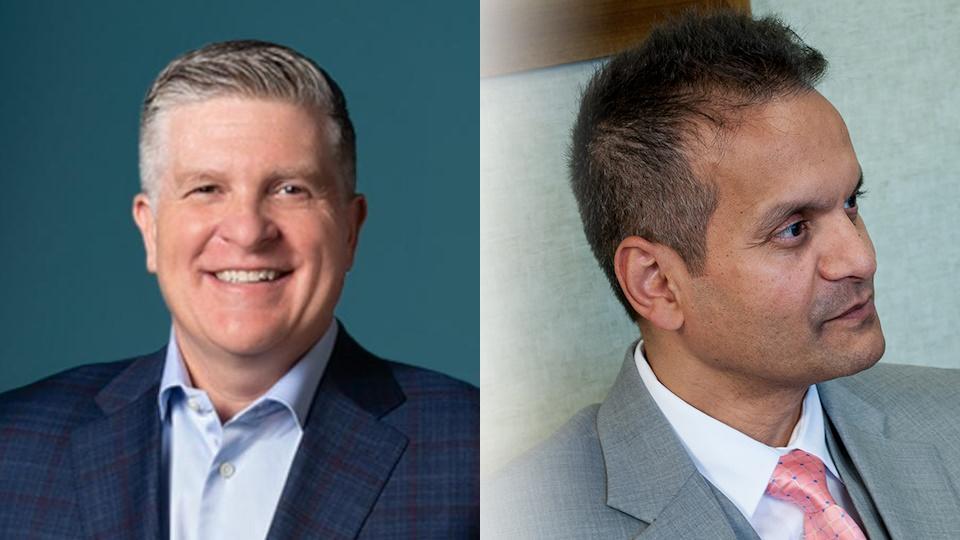Reconfiguring COVID and influenza vaccines for long-term effectiveness

Alexandre Le Vert, CEO and co-founder of Osivax, discusses the company's breakthrough vaccine technology, oligoDOM, and how it's driving the development of new influenza and SARS-CoV-2 vaccines that attack T-cells, providing a long-lasting effect.
Currently, available vaccines for influenza and COVID-19 require yearly administration due to their makeup, as they target the outer layer of the virus. Le Vert says Osivax's technology differs, however, as it attacks the virus' T-cells, making the vaccine more effective in the long term, and that clinical trials have shown promise.
"Osivax is a European-based biotech company that develops vaccines against infectious diseases. What makes us special is that we have this technology platform that allows us to target the internal parts of a virus. Therefore, we're focusing our vaccines on non-mutating parts," Le Vert says.
As a virus mutates, the outer layers change more quickly than the inner layers. Attacking the non-mutating parts or the inner layers can create a more effective vaccine that will be sustainable through several viral mutations.
The technology
When exposed to a virus, one's immune system develops antibodies in response to foreign antigens, with or without a vaccine. However, a vaccine trains the immune system to recognise that familiar virus and kill it more rapidly.
"Sometimes the difference between life and death is your immune system being ready within two days versus within five days. That's really what a vaccine does: it helps your immune system be ready to fight the virus within one or two days versus five, six, or seven days without a vaccine," Le Vert states.
When training the immune system, the science becomes complicated, as different aspects of the system play different roles.
One arm of the immune system triggers antibodies, and the other triggers T-cells. Antibodies cover the pathogen of the virus and neutralise it. They'll prevent the virus from entering the cells because they will be covered with antibodies, and the receptors will be unable to reach the cell.
"On this front, the antibody works very well. But the antibody won't be able to access the internal parts of the virus," Le Vert states.
Another arm of the immune system is called the T-cell response, which destroys the cells that have been infected by the virus.
"The virus has to enter into a cell to hack the cell and make the cell produce new viruses. The beauty of that T-cell response is that you can actually access the internal parts of the virus," Le Vert states.
Osivax's technology, oligoDOM, trains the T-cell immune response to recognise the nucleoprotein.
"When the virus infects a cell, it will take that cell and make it produce all the parts of the virus – including the nucleoprotein. Then the virus reassembles and kind of merges out. But when a cell produces those viral particles or antigens, it will be marked with traces of each of these particles on its surface," Le Vert states.
"This is how the cell, which has been infected, exposes all the parts of the virus. That's where you can act and target these internal parts of the virus, but you have got to be very fast, very strong, because you can't wait too long after the cell has been infected. Otherwise, it will start producing all these replicate viruses."
The nucleoprotein is exposed at the cell's surface and a robust T-cell response at that time can get rid of the virus. The virus can't divide and so disappears.
The company is using its oligoDOM technology to create influenza and COVID-19 vaccines which it hopes will provide long-term protection against the viruses.
Influenza
The influenza virus mutates quickly and, over the past decade, has shifted to where the vaccines available are less effective than they previously were.
The CDC analyses the effectiveness of flu vaccines yearly and has done so since the 2003/2004 flu season. Just eight years ago, the efficacy of flu vaccines was 52%. Analysis from the 2021-2022 flu season shows a vaccine effectiveness of 35%.
"Everyone understands this is related to how fast the virus can mutate. So, we decided to use our approach to target an internal, non-mutating part of the virus, the nucleoprotein, and to develop a broad-spectrum vaccine against that using oligoDOM," Le Vert states.
Osivax's influenza vaccine is in phase 2A studies. Over 800 subjects have been recruited for four clinical trials, with 72 to 300 subjects in the various trials.
"We observed efficacy in our clinical trial in decreasing the confirmed symptomatic influenza by a matter of 78%. We don't have an internal comparison in this clinical trial, but the effectiveness of the current vaccines is much lower," Le Vert states.
"We don't know what it will do in a head-to-head comparison because we haven't done that, but we're very enthusiastic about those results. It's unprecedented, according to us. And it's the second time we see such a level of protection with our vaccine in our hands."
In 2019/2020, the company published an observed efficacy of 75%. Then in 2021/2022, it saw a 78% reduction in confirmed influenza symptoms.
"There's still a lot of work to be done, but we see this as a big hope for the future prevention of all these mutating strains of influenza. It'd be amazing if we could anticipate the mutations of influenza, and we wouldn't have to react every year with nine months’ delay," Le Vert states.
In addition to Influenza, La Vert says Osivax is testing its technology to be used against current and potentially future strains of COVID.
SARS-CoV-2
When COVID initially hit, there was a scramble within the vaccine community to cultivate an effective vaccine to help stop or lessen the detrimental effects of the virus.
"In 2020, when we saw the COVID-19 wave arriving, we thought of how we could help. Even though we were hoping to get antibody vaccines, at least for the first strains, we thought it'd be important to have the same approach as with our flu vaccine. What if mutation starts to appear, which is just the typical way of life, and what if mutations help the virus evade vaccine effectiveness? It would be useful to have a vaccine to anticipate these mutations," Le Vert says.
The company uses the same approach for the COVID-19 vaccine as influenza, but to train the immune system to recognise the nucleocapsid – a protein that forms complexes with the positive-sense RNA genome of coronaviruses.
One difference between the current COVID vaccines, the mRNA or the Novavax subunit vaccine, is that they're targeting the outer membrane of the COVID-19 virus – the spike protein.
"One can argue that mRNA's and even the Novavax vaccines also trigger T-cells, but not against the nucleocapsid. We're targeting specifically the nucleocapsid with T-cells that are going to be effective," Le Vert says.
The vaccine candidate is in the preclinical phase today, but has shown promising results in animal trials. The company is looking to begin human trials next year.
“If we manage to have protection against one strain, it should protect against all the other variants, and then potentially beyond COVID-19, in other coronaviruses. Also, the mutation rate of the nucleocapsid is just orders of magnitudes below the one with the spike. So, the level of mutations you get with a spike in one year is what you would get in a nucleocapsid in probably many years," Le Vert states.
"Vaccine developers have done an amazing job with COVID-19, but now we're seeing that these vaccines have their limitations. Why on earth do we need to change the vaccines every year? It's not the case with measles or polio; with these child infectious diseases. It just takes a lot of work and a lot of good science, but we're ready for that."
About the interviewee
 Alexandre Le Vert, CEO and co-founder of Osivax, has more than 20 years of experience in healthcare ranging from research and development to commercialisation of vaccines and therapeutics. He is an experienced entrepreneur in biotech and innovation, and currently serves as a board member of several biotech companies in France and in the US. Alexandre is a graduate of École Polytechnique and Harvard University.
Alexandre Le Vert, CEO and co-founder of Osivax, has more than 20 years of experience in healthcare ranging from research and development to commercialisation of vaccines and therapeutics. He is an experienced entrepreneur in biotech and innovation, and currently serves as a board member of several biotech companies in France and in the US. Alexandre is a graduate of École Polytechnique and Harvard University.
About the author
 Jessica Hagen is a freelance life sciences and health writer and project manager, who has worked with medical XR companies, fiction/nonfiction authors, nonprofit and for-profit organisations, and government entities.
Jessica Hagen is a freelance life sciences and health writer and project manager, who has worked with medical XR companies, fiction/nonfiction authors, nonprofit and for-profit organisations, and government entities.












